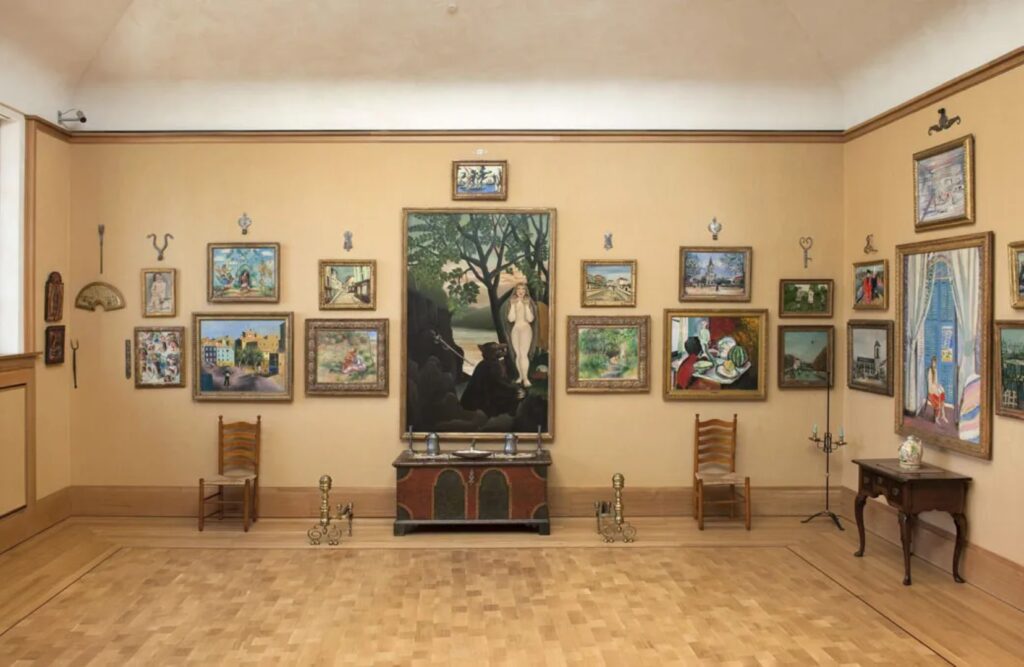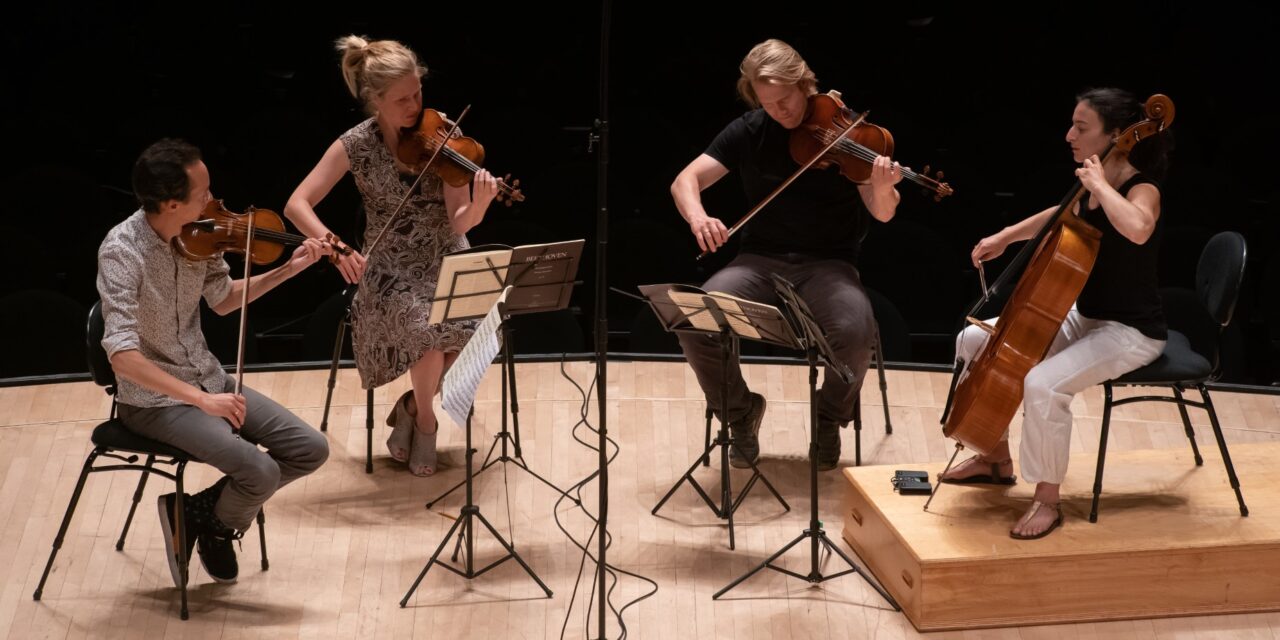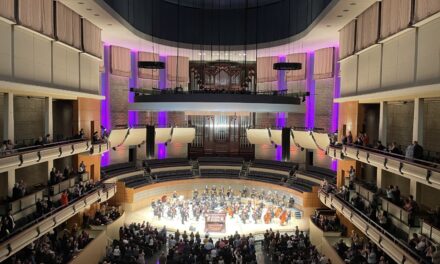Four players from the Calgary Philharmonic join the Garneau
Review by Mark Morris
header photo by Erik Visser
Gabriella Smith (b. 1991): Carrot Revolution
Felix Mendelssohn (1809-1847): String Quartet No.3, Op.44 No.1
George Enescu (1881-1955): String Octet in C Major, Op. 7
Garneau String Quartet
with
Diana Cohen (violin), Maria van der Sloot (violin), Jesse Morrison (viola), and Arnold Choi (cello)
Muttart Hall
April 5, 2025
The Garneau String Quartet finished their 2024/2025 in fine style, in what was their last concert in the Muttart Hall before it is no longer available to Edmonton’s chamber musicians.
For the occasion they had invited a quartet of players from the Calgary Philharmonic to join them: violinists Diana Cohen and Maria van der Sloot, violist Jesse Morrison, and cellist Arnold Choi. It was these four who kicked off the concert very energetically, with an exhilarating piece for string quartet by the Californian composer Gabriella Smith.
Written in 2015 for the Aizuri Quartet, its title, Carrot Revolution, was inspired by a Cézanne quote: “The day will come when a single, freshly observed carrot will start a revolution”, but took as its starting point the art collection by Dr. Albert C. Barnes. Here “Masterpieces by Vincent van Gogh, Henri Matisse, and Pablo Picasso hang next to ordinary household objects—a door hinge, a spatula, a yarn spinner. On another wall, you might see a French medieval sculpture displayed with a Navajo textile.”

“I envisioned the piece,” wrote Smith, “as a celebration of that spirit of fresh observation and of new ways of looking at old things, such as the string quartet – a 250-year-old genre – as well as some of my even older musical influences (Bach, Perotin, Gregorian chant, Georgian folk songs, and Celtic fiddle tunes).”
In fact, the 12-minute piece feels homogeneous and unified, with the ending bringing back the opening. It starts with some harsh rhythmically driving sounds using extended string techniques, then settles, via jazzy influence with a plucked bass on the cello, into a strong sense of perpetual motion. Throughout the rhythm is maintained, sometimes to the fore, sometimes quietly in the rear, and it is the rhythm of trains, more specifically steam trains. Indeed, at around two-and-a-half minutes, it sounds uncannily like Steve Reich’s Different Trains, written for the Kronos Quartet. I am sure this was entirely unconscious, but by the end it felt like a composer take the overlapping broken rhythms and minimalist repetition of the earlier piece, and recasting the basics into a 21st musical take.
Towards the end there is a more meditative section, mirroring the jazzy section at the beginning, before conventional string sounds revert to the harsh and metallic, keeping that driving rhythm. I loved it, and it was played with immense gusto and a feeling of authority by the four Calgarians.
The Garneau themselves then took the stage for a very different work, Mendelssohn’s String Quartet No.3, Op.44 No.1. It was composed in in July 1838, by when Mendelssohn, at 29, was well established as a mature genius, and not just the child prodigy that produced the Octet which some may have heard played by the Garneau and New Orford Quartets on April 6 (review).
The String Quartet No. 3 is decidedly from the pen of the composer whom the English so loved, music of the ordered life, clearly so professional, yet in no way challenging, let alone threatening (he made ten trips to the UK in all: Queen Victoria and Prince Albert were great admirers). This side of Mendelssohn’s writing divides audiences, and I am afraid I am on the side of those who find it just too neat and refined. But it must be fun to play, and the Garneau opened it with their usual energy, with first violin Robert Uchida almost physically dancing the music. The second movement, Menuetto. Un poco Allegretto, is perhaps the most successful, with its continuous melody writing. The Garneau effectively took it slightly slowly, and there was some lovely playing in the folk-song melody passage for the first violin.
The Andante espressivo ma con moto third movement really is music of the refined salon, and you can see why the English bourgouisie so enjoyed the composer’s music – easy to follow, and with few intellectual demands. It is music of the ordered life. The final Presto con brio was indeed taken with brio – the Garneau are so good at this kind of mood.
For the final work in the concert, the Edmontonians and the Calgarians joined together to form a string octet. The work they had chosen to play is a wonderful masterpiece that is all too rarely heard: the String Octet in C Major, Op. 7 by the Romanian Georges Enesco. Born in 1881, he was one of the most famous violinists of the first half of the 20th-century, and an exceptional teacher (his students included Yehudi Menuhin, Christian Feeras, and Arthur Grumiaux). He was also a fine pianist (and had a staggering musical memory – he could play all of Wagner from memory on the keyboard, and he memorized all Bach’s works!). Above all, he was the most important Romanian composer of the 20th century, though his music is now all too little performed in North America.
The Octet, composed in 1900, but not premiered until 1909, is remarkable music for a 19-year old. Enescu himself saw it as being the work where he found his own voice. Like Mendelssohn, he wrote it for an octet – in other words, a consort of eight string instruments rather than for two separate string quartets, and it does sound symphonic (in 1950 he sanctioned a string orchestra version of the work).
It also has an inventive structure. The whole piece is in one sonata form (movement one is the exposition, movement two the development of the first subject, the lyrical third movement a subsidiary subject, the final the recapitulation), but at the same time it can been seen more conventionally as a four-movement work.
Schoenberg was to try a similar pattern in 1906, in the Chamber Symphony No.1 Op.9, and Enescu’s music, like Schoenberg’s, is on the cutting edge of musical ideas in the first decade of the 20th century. It is a very late Romantic work, ranking alongside works of the period by his contemporaries the Hungarian Bartók (born in the same year), the Pole Karol Szymanowski (born a year later), the Austrian Alexander Zemlinsky (a decade older), and with similar sensibilities. At one point, one is strikingly reminded of Schoenberg’s Verklärte Nacht, written in 1899, but not performed until 1902 (so Enescu couldn’t have heard it before writing the Octet).
Consequently the emotions it elicits are as important as the structural experiments it tries, and they are considerable. Like Bartok and Szymanowski, Enescu was interested in the folk music of his country, and there are folk-music inflections entwined throughout the rich romantic colours and tone – including the use of a drone. And powerful emotions they are, the kind of music that conjures up images, from the drive of the first movement, through drama, as if a storm was suddenly starting, the wind getting up out of nowhere, to the lovely lyrical slow movement, with its distant sens of a chorale. It churns and it drives and it sings, and, in keeping with the fluid stretching of harmonies of the period, it doesn’t really ever sound as if it is written in its key of C major.
This was a gripping performance, high energy, complete commitment, with the climaxes creating perhaps the loudest (and most thrilling) sound I have ever heard in the Muttart. There was very sensitive playing from Uchida, some lovely viola tones from Morrison, a tiny magical solo from violinist Laura Veeze – but above all it was the effect of the concerted strings, rather than any solo work, that made this performance so forceful.
What an adventurous choice for this concert, and how lucky we were to have the opportunity – a rare one indeed – to hear it!




